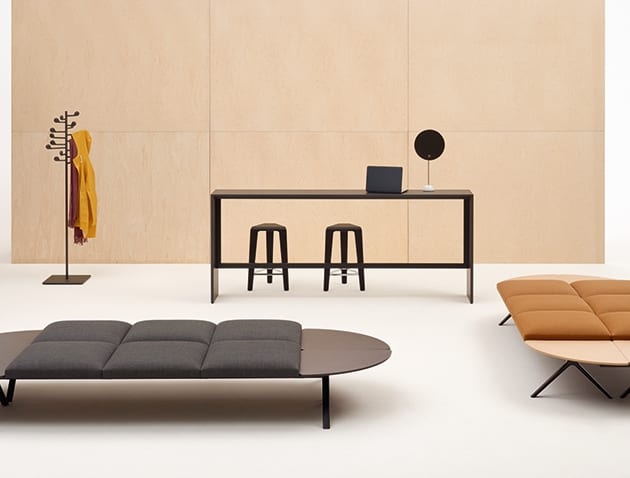 ||||||||||
||||||||||
One of the most enduring trends in design is certainly the blurring of the boundaries between work and living spaces. Over the years brands and designers have been investing heavily in modularity, flexibility, and adaptability; leaving behind the sterile corporate workplace style once and for all.
Arper has long since been a trendsetter in this sense, their modular Loop collection by Lievore Altherr Molina, dates back to 2009. It’s now hoping to replicate this success, with Kiik, a new collection by Iwasaki Design.
Launched globally at Milan Salone del Mobile, and in the UK during Clerkenwell Design Week, this modular line of seating, tables, ottomans, and consoles creates moments for working, gathering, or relaxation in graphic forms with myriad configurations. Kiik’s fundamental structures can be created with seats with and without backrests and tables in triangular, circular, square or rectangular shapes and completed with ottomans and low or raised consoles.
OnOffice caught up with Ichiro Iwasaki, during Salone del Mobile, to discuss all things design.
OnOffice: How is designing for office/workplace different from creating home pieces?
Ichiro Iwasaki: Nowadays, design for office is more focused on ‘ Move ‘, things like having discussions with colleagues or quick meetings while standing.Working environment requires efficiency in motion.
On the other hand, of course design for home is more close to ‘ Stillness ‘, as home is place to rest or relax. However, I feel the contexts of those two environments are getting mixed nowadays.
OnOffice: What was your vision when approaching this collaboration? What are you hoping to achieve now that the Kiik line has launched?
Ichiro Iwasaki: The vision was to create modular system that can be applied to various contexts in our contemporary life styles.
The system consists of 3 basics postures from our every day life: console for ‘ Standing ‘, Sofa-bench for ‘ sitting ‘ and Ottoman for ‘ lying down’.
This approach made the modular system of KIIK highly flexible to any kinds of spaces.
OnOffice: It’s important to keep your own voice as a designer and maker but to speak the language of the client, as it were. How do you approach these types of collaborations?
Ichiro Iwasaki: In my design career, I designed many industrial products such as consumer appliances, cameras, and phones which are full of restrictions and no room for expressing myself.
Hence it is rather natural for me to speak Arper’s language instead of mine.
OnOffice: How did you bridge the aesthetic and philosophical differences between Japanese and Italian design?
Ichiro Iwasaki: I think there are full of wonderful values in the differences, and you can discover them if you tried to understand more.
Generally speaking, we tend to regard the differences as something negative or pessimistic, however to me it’s almost a treasure.
OnOffice: What did Arper want when they approached you for a partnership? What were they looking for?
Ichiro Iwasaki: Arper asks designers to explore what is Arper. Probably they expected answers from different perspectives based on my experiences of industrial design (such as electronics) and also my Japanese background.
OnOffice: What were you looking for in a partnership with a heritage brand like Arper?
Ichiro Iwasaki: I keep looking at Arper more than 10 years now, and to me, Arper always seems like a project not just as one of the brands.
It wasn’t like designing for a brand, but collaborating together to realize philosophy of the brand. This highly motivates me a lot.
OnOffice: What was the process like? How much collaboration was there? Was it easy/smooth?
Ichiro Iwasaki: At the beginning of project, we always share what we should do, aim, goals and discuss every small detail.
This allows our collaboration always smooth and clear.
OnOffice: Japanese designers like yourself seem to have taken over Europe this year. Why is European design falling in love with Japan?
Ichiro Iwasaki: As well as Japanese people are interested in Europe, there must be always interests, expectations and also desires between different cultures.
It is a kind of mutual expectations rather than one-sided.
I think there can be a type of design only possible because of this mutual expectations.
Iwasaki Design Studio’s new Kiik collection for Arper is flexible and playful, without losing it’s utilitarian edge. Ichiro Iwasaki sat down with OnOffice to discuss Japanese design and his process.






















